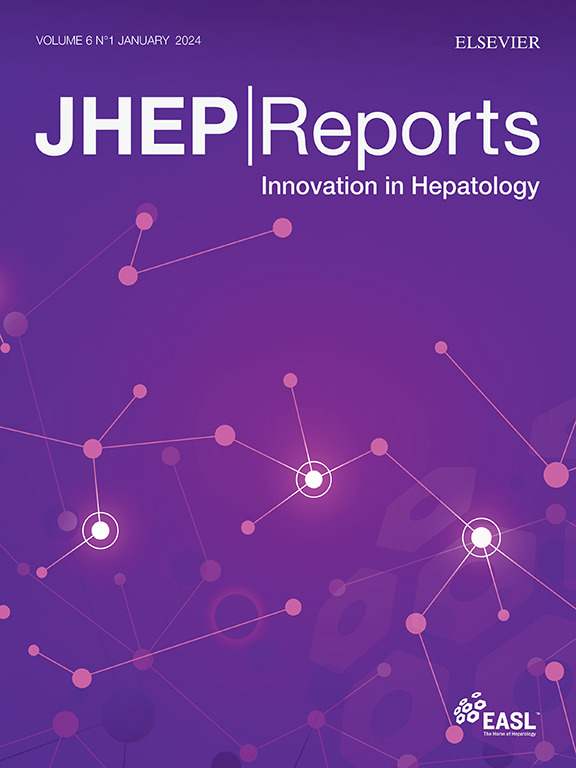Therapy with murinized tobevibart and elebsiran is efficacious in a liver-chimeric mouse model of HDV infection
IF 9.5
1区 医学
Q1 GASTROENTEROLOGY & HEPATOLOGY
引用次数: 0
Abstract
Background & Aims
Chronic hepatitis delta virus (HDV) infection represents the most severe form of viral hepatitis. HDV is a satellite virus of hepatitis B virus (HBV) and depends on the hepatitis B surface antigen (HBsAg) for envelopment and viral entry. Tobevibart (VIR-3434) is an investigational monoclonal antibody targeting the antigenic loop of HBsAg. Elebsiran (VIR-2218) is an investigational RNAi therapeutic targeting a highly conserved region within the HBV genome. The aim of this study was to investigate the antiviral effect of tobevibart and elebsiran on HDV infection in preclinical models.
Methods
In vitro antiviral activity was determined in an HBV/HDV coinfection model in primary human hepatocytes (PHHs) or Huh7-NTCP cells. The in vivo efficacy of a murinized version of tobevibart alone or in combination with elebsiran was evaluated in HBV/HDV-coinfected liver-chimeric mice.
Results
Elebsiran treatment reduced levels of secreted HBsAg and infectious HDV with picomolar potency. Tobevibart exhibited pan-genotypic neutralizing activity against all tested HDV genotypes with EC50 ranging from 1.1 to 4.6 ng/ml. Combination treatment with tobevibart and elebsiran reduced infectious HDV levels in HBV/HDV-coinfected PHHs in an additive manner. In vivo, compared to vehicle, treatment with elebsiran, murinized tobevibart, or their combination significantly decreased HDV RNA serum levels by 0.7 log (p <0.0001), 1.6 log (p = 0.0034) and 2.1 log (p = 0.0002), respectively (measured at day 14 for elebsiran or day 21 for murinized tobevibart and the combination). HBsAg serum levels were reduced by 0.6 log (p <0.0001), 2.0 log (p <0.0001) and 2.8 log (p <0.0001), respectively.
Conclusions
Tobevibart and elebsiran exert potent antiviral activity as single agents and in combination. The data support the clinical development of tobevibart and elebsiran for the treatment of patients with chronic HDV infection.
Impact and implications
Chronic hepatitis delta is the most severe form of viral hepatitis and is associated with rapid progression of liver-related diseases and a high risk of hepatocellular carcinoma development. To date, there are only limited treatment options available. Tobevibart and elebsiran are currently being evaluated in clinical trials for the treatment of HDV (phase III) and for the treatment of HBV (phase II). The current study demonstrates that tobevibart and elebsiran are efficacious in preclinical models of HBV/HDV coinfection, supporting their clinical development.
在肝炎病毒感染的肝脏嵌合小鼠模型中,用小鼠化的tobevibart和elebsiran治疗是有效的
背景,慢性丁型肝炎病毒(HDV)感染是病毒性肝炎最严重的形式。HDV是乙型肝炎病毒(HBV)的卫星病毒,依靠乙型肝炎表面抗原(HBsAg)包膜和病毒进入。Tobevibart (VIR-3434)是一种正在研究的靶向HBsAg抗原环的单克隆抗体。Elebsiran (VIR-2218)是一种研究性RNAi治疗药物,靶向HBV基因组中高度保守的区域。本研究的目的是在临床前模型中研究tobevibart和elebsiran对HDV感染的抗病毒作用。方法采用人原代肝细胞(PHHs)和Huh7-NTCP细胞HBV/HDV共感染模型,测定体外抗病毒活性。在HBV/ hdv共感染的肝脏嵌合小鼠中评估了小鼠化版tobevibart单独使用或与elebsiran联合使用的体内疗效。结果selebsiran治疗可显著降低HBsAg分泌水平和感染性HDV水平。Tobevibart对所有测试的HDV基因型具有泛基因型中和活性,EC50范围为1.1至4.6 ng/ml。tobevibart和elebsiran联合治疗以一种累加的方式降低了HBV/HDV共感染phh的传染性HDV水平。在体内,与对照体相比,elebsiran、tobevibart微量化或两者联合治疗显著降低了血清HDV RNA水平,分别降低了0.7 log (p <0.0001)、1.6 log (p = 0.0034)和2.1 log (p = 0.0002) (elebsiran在第14天测量,tobevibart微量化和联合治疗在第21天测量)。血清HBsAg水平分别降低0.6 log (p <0.0001)、2.0 log (p <0.0001)和2.8 log (p <0.0001)。结论bevibart和elebsiran单用和合用均具有较强的抗病毒活性。这些数据支持tobevibart和elebsiran用于治疗慢性HDV感染患者的临床开发。影响和意义慢性丁型肝炎是最严重的病毒性肝炎形式,与肝脏相关疾病的快速进展和肝细胞癌发展的高风险相关。迄今为止,只有有限的治疗选择。Tobevibart和elebsiran目前正在治疗HDV (III期)和HBV (II期)的临床试验中进行评估。目前的研究表明,tobevibart和elebsiran在HBV/HDV合并感染的临床前模型中是有效的,支持了它们的临床开发。
本文章由计算机程序翻译,如有差异,请以英文原文为准。
求助全文
约1分钟内获得全文
求助全文
来源期刊

JHEP Reports
GASTROENTEROLOGY & HEPATOLOGY-
CiteScore
12.40
自引率
2.40%
发文量
161
审稿时长
36 days
期刊介绍:
JHEP Reports is an open access journal that is affiliated with the European Association for the Study of the Liver (EASL). It serves as a companion journal to the highly respected Journal of Hepatology.
The primary objective of JHEP Reports is to publish original papers and reviews that contribute to the advancement of knowledge in the field of liver diseases. The journal covers a wide range of topics, including basic, translational, and clinical research. It also focuses on global issues in hepatology, with particular emphasis on areas such as clinical trials, novel diagnostics, precision medicine and therapeutics, cancer research, cellular and molecular studies, artificial intelligence, microbiome research, epidemiology, and cutting-edge technologies.
In summary, JHEP Reports is dedicated to promoting scientific discoveries and innovations in liver diseases through the publication of high-quality research papers and reviews covering various aspects of hepatology.
 求助内容:
求助内容: 应助结果提醒方式:
应助结果提醒方式:


